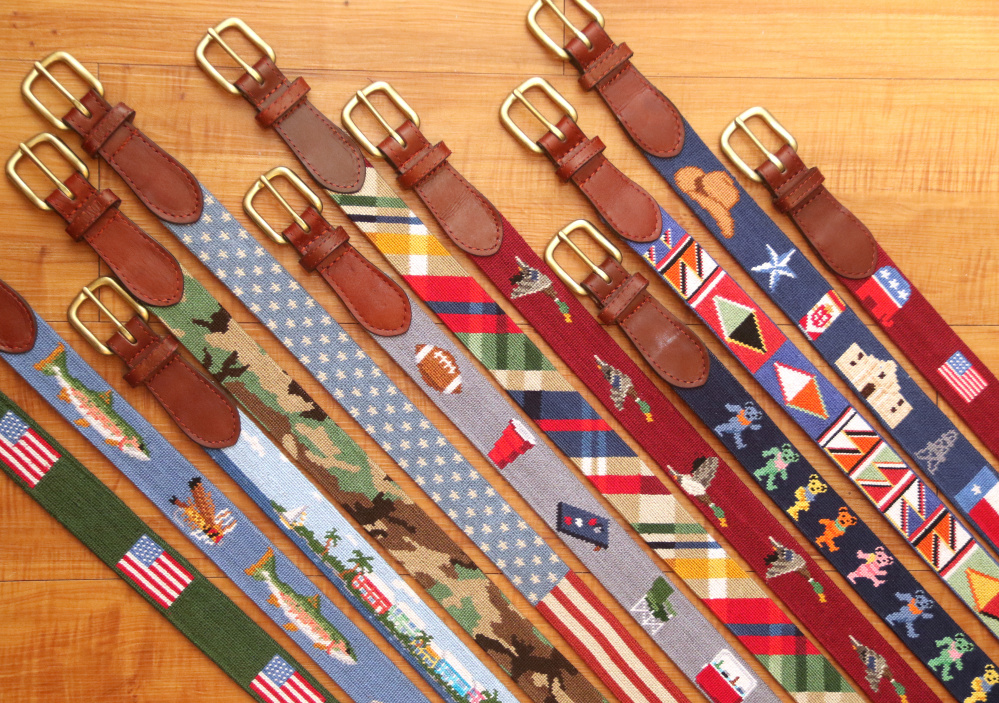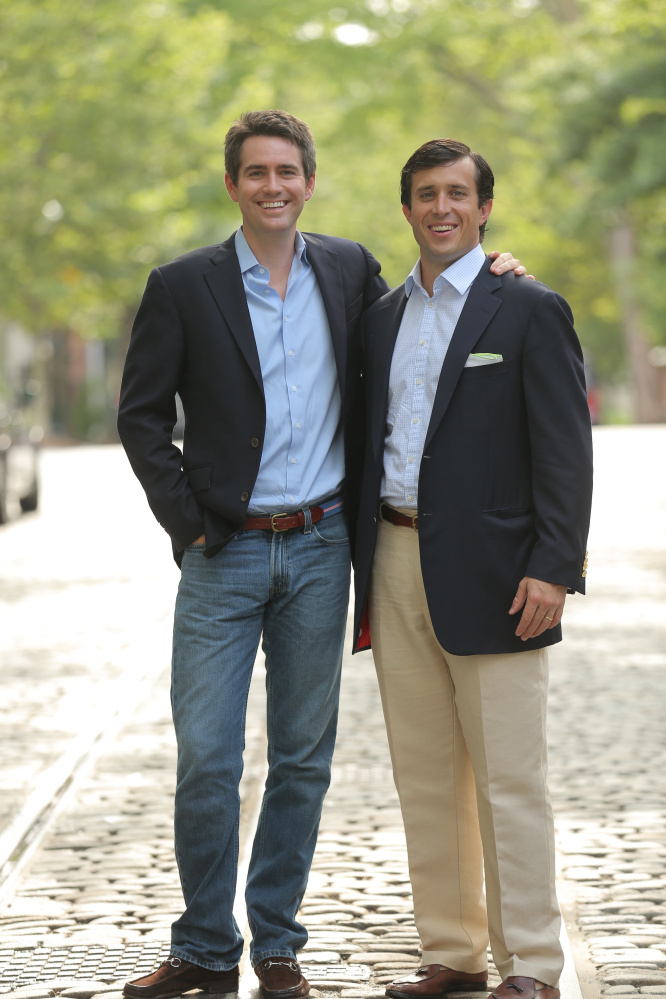In the never-ending quest for that perfect guy gift, a small company in Bethesda, Maryland, has cornered a niche market of male preppy chic: needlepoint belts. In fact, it’s fair to say that Smathers & Branson is the world’s pre-eminent men’s needlepoint accessories brand. If that’s your thing.
It’s a presidential thing: George H.W. Bush and Bill Clinton have both been spotted wearing the company’s American flag belt. And a sports thing: Peyton and Eli Manning have needlepoint belts bearing the logos of their alma maters. And a frat thing, because what college boy doesn’t need a belt festooned with bourbon, beer cans or pink elephants? And a hobby thing, because for some people, sailing or golfing or Christmas movies aren’t a complete experience unless there’s a needlepoint version wrapped around their waist.
Call it traditional, WASPy, classic or tongue-in-cheek, but it’s working. The 10-year-old company is featured in 1,500 stores nationwide, including J. Crew and Nordstrom.
On a recent day, the Bethesda offices in an unassuming strip mall are empty. All the employees, including official dog greeter Moose, are two floors below, in the warehouse, furiously packing belts, wallets, hats, flasks, key fobs and other needlepoint adornments to arrive before Christmas Eve.
BEGINS WITH A GIFT
And it all began, as so many things do, because a girl wanted to impress a boy.
The company started at Bowdoin College in Maine, where Austin Branson and Peter Smathers Carter were roommates. Austin, 34, grew up in Bethesda and went to St. Albans; Peter, 33, attended Deerfield Academy in Massachusetts before returning to his native Maine.
But it really started in Italy, where Austin fell in love during the fall of his junior year. His girlfriend, a fellow exchange student, made him a needlepoint belt for his 21st birthday: little pink elephants drinking martinis and his initials. He thought it was sweet but didn’t really get the significance of the gesture.
“It meant nothing to me at the time,” he says, sitting in his decidedly modest office. “I dutifully wore it.”
Turns out that among a certain set, handmade needlepoint belts are a sign of a serious relationship, like exchanging class rings or other tokens of love. One belt can take 40-50 hours to stitch, then has to be sent away to be completed. With the parts and assembly, the cost runs up to $300 – a considerable investment for a college student. (They’re also known as “breakup belts,” because so many relationships end before the belt is finished.)
Austin just wanted to keep his girlfriend happy and wore the belt around campus where, to his surprise, he received a lot of compliments. “No one had admired my waist before,” he said. A few months later, Peter received a handmade belt with sailboats from the girl he was dating. He also dutifully donned it and got stopped all the time, especially during the summer. “It was an accessory that really jumped, and that was the eureka moment for us,” Austin says.
BRAINSTORMING BEGINS
The two friends started brainstorming: Nothing similar was available in stores. What if they could get the price down and customers didn’t have to wait six months?
And so a business was born. The two began teaching themselves everything they could about needlepoint, including how to master the tight, even stitches. Peter practiced in their dorm room; Austin while traveling to and from lacrosse matches. “I was captain of the team and no one could make fun of me,” he explains. “So I sat on the back of the bus and tried to figure out how to do it.”
The college administrators allowed them to pursue independent study on both the design and business sides. And they kicked around a lot of names before settling on something safe and traditional sounding: Smathers (Peter’s middle name and his college nickname) got top billing for obvious reasons, says Austin: “Which sounds better: BS or SB?”
After graduation in 2004, they both moved into the basement of Austin’s parents’ home in Bethesda and created their first collection for the “classic American guy” who wears polo shirts and khakis: There was a flag belt (which remains the company’s bestselling item) and belts with golf, fishing, sailing and horse racing motifs, plus flamingos with margaritas and the pink elephant martini design. They found a manufacturing partner in Vietnam and asked their parents for frequent flier points as Christmas presents so that they could fly there and teach the villagers to stitch the belts properly.
1,000 THE FIRST YEAR
The first year they sold 1,000 belts, mostly by driving up and down the East Coast and walking into small men’s stores wearing their product. They were a big hit in the South, where needlepoint is part of fraternity fashion and preppies like the pop of color. The business grew slowly, expanding to key fobs, wallets, flasks, dog collars, hats and pillows, introducing about a dozen new designs each season.
From the very beginning, patriotic themes were a hit. “American flags are completely timeless,” Austin says. The classic flag on a navy background is the only remaining design from the first collection. One member of the extended Bush family attended Bowdoin and bought one of the belts for George H. W., who was later photographed wearing it while fishing with Vladimir Putin and golfing with Tiger Woods. “Really, really cool for us,” Peter says. They’re not sure how Clinton got one, but he has been spotted wearing it a few times, most notably at an Obama rally with Bruce Springsteen.
The Americana theme now includes historic flags, as well as Democratic and Republican logos. College licensing has proven to be very popular: The company started with 15 schools and now feature products for 85 colleges and universities. They recently added Major League Baseball and the National Hockey League to the roster, with both Washington Nationals and Capitals accessories.
POISED TO SELL 300,000 THIS YEAR
And since you asked, hand-stitched needlepoint doesn’t come cheap: Belts retail for $165, wallets for $115, flasks for $65. The two owners didn’t disclose revenue figures for the private company, but it has exceeded all their cautiously optimistic expectations. Last year they sold 250,000 belts and other accessories; this year, they’re poised to reach 300,000.
It’s still a small operation, with 30 employees in Bethesda, including six designers; the original 50 artisans in Vietnam have expanded to thousands. Because every item is hand-stitched, the company has a custom line for weddings (flasks are big as groomsmen gifts) and “life belts” with individualized motifs that reflect the recipient’s interests and hobbies.
The brand is now in stores all over the United States. The products are still primarily designed for men, although many of the customers are wives and mothers. “It’s a guy thing,” Peter said, “but the first belt a man gets, most of the time, a woman buys it for him.”
Next up: More for their new Parlour line, with slightly hipper designs, plus more golf, home and children’s products. Peter has a 7-month-old baby; Austin is giving his 3-year-old daughter a life belt for Christmas featuring donuts, ice cream and a soccer ball.
And lest you question the power of the needlepoint belt, remember the girl who made that first one for Austin? He married her.
Copy the Story LinkSend questions/comments to the editors.




Success. Please wait for the page to reload. If the page does not reload within 5 seconds, please refresh the page.
Enter your email and password to access comments.
Hi, to comment on stories you must . This profile is in addition to your subscription and website login.
Already have a commenting profile? .
Invalid username/password.
Please check your email to confirm and complete your registration.
Only subscribers are eligible to post comments. Please subscribe or login first for digital access. Here’s why.
Use the form below to reset your password. When you've submitted your account email, we will send an email with a reset code.